|
|
|
30 September 07:
THE TEAM TO BEAT, NL East Champs!
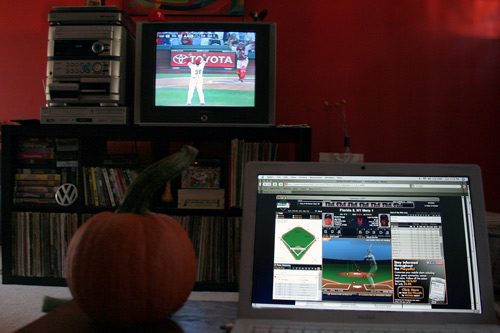
AHHHHHHHHHHHHHHHHHHHHHHHHH!!!!!!!
Breathe.
Holy cow.
AHHHHHHHHHHHHHHHHHHHHHHHHH!!!!!!!

Jimmy Rollins, National League MVP.
Matt Holliday's outstanding season for Colorado notwithstanding, Rollins' play in Sunday's deciding game should be all the proof the baseball writers need to make it
official. J-Roll was amazing down the stretch, but particularly in the clutch. He led off all three games against the Braves with hits, and in the clincher today against
the Nats, he manufactured his own runs AND got his 20th triple of the season to become only the fourth player in MLB history with 20 HR, 2B, 3B and SB. Plus he's a leadoff
hitter with 94 RBIs, thanks half in part to being the clear leader of an offensive minded team, and half to the fact he blew away the MLB record for at-bats in a season,
ending with 713, eight more than Willie Wilson in 1980, the year Tug McGraw struck him out to clinch the World Series for the Phillies.
All together now: MVP! MVP! MVP!
Also, this has to be said: Charlie Manuel has done one hell of a job. To anyone who's watched the Phillies play this season, that's not exactly a revelation, but to longtime
Skyline readers, my saying this is a pretty big admission. Uncle Cholly still made some boneheaded decisions this year, but they paled in comparison to his cool head and
clear direction of an emotional team that often needed it. If he wins Manager of the Year, I will happily eat crow, because he deserves it.
But speaking of eating crow, never mind me. Right now, at 5 o'clock post-meridian on Sunday the 30th of September, I'd like to turn everyone's attention to the New York
Post's Sunday edition from exactly five weeks ago, specifically to this column:
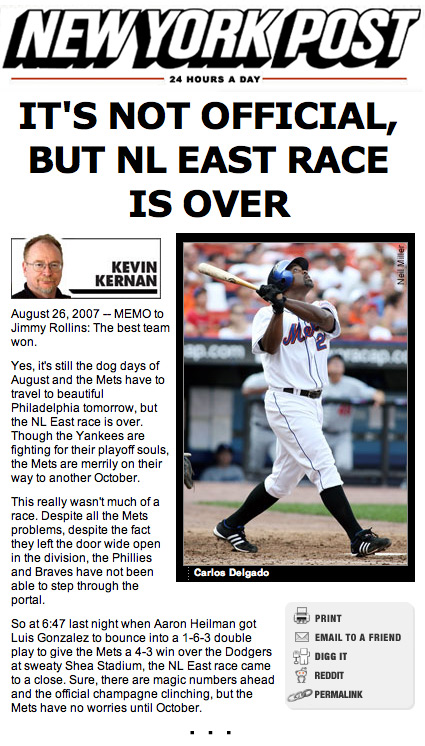
(Click that image to go to the full story at nypost.com.)
This ridiculously arrogant column continues with such quotes as "The Mets simply have more weapons than anyone else in the East", "The Mets biggest challenge is to stay
interested in the final five weeks of the season and to have the eye of the tiger when they get to the postseason" and "'We're in a great position,' Glavine said. 'All we
have to do is take care of business and win our games and it doesn't matter what anybody else does.' . . . Considering the talent disparity in the division, it never really
mattered."
Ah yes, that NL East disparity. The Mets are so talented that no one else had a chance. Just like last season, when they ran away with the World Series. Oops, my bad. I
meant with the NL East, only to watch the Cardinals win the pennant on the green grass of Shea Stadium en route to their World Series win. Anyway, the best part of that NY
Post column is that its author, Kevin Kernan, concludes it with his email address, kevin.kernan@nypost.com. Maybe you'd like to drop ol' Kevin a line and remind him that, in
fact, the NL EAST RACE IS OVER. I did.
But screw Kevin, it's Phillies time. Their divisional playoff series begins right here at Citizens Bank Park on Wednesday with the winner of a one-game Wild Card playoff
between the Colorado Rockies, who stayed alive today with a win over NL West winner Arizona, and the San Diego Padres, who as Gary Matthews pointed out a number of times
today, did NOT pitch Cy Young shoo-in today and paid for it, losing in Milwaukee. Who cares who it is, bring em on. The Philadelphia Phillies are in the playoffs,
BOYEEEEEEEEEE!
* * *
Some other end-of-the-regular-season observations from someone who attended 23 games and watched just about all 139 other ones . . .
• Pat Burrell deserves consideration for Comeback Player of the Year.
• Cole Hamels is amazing and has a long career ahead of him. His curveball on Friday was, as Sarge said, filthy.
• Ryan Howard can strike out twice a game as long as he keeps putting up the numbers he does, especially in the clutch down the stretch, just like he did last year. By
not striking out today, he avoided becoming the first player in MLB history to strikeout 200 times in a season. You know what? That's a fair tradeoff for 47 HR and 136 RBI,
which won him the NL RBI crown.
• JC Romero, Tom Gordon and Brett Myers down the stretch: wow.
• Tom Glavine may be the Hall of Famer, but Jamie Moyer had his number this year, most especially on the last day of the year, when he didn't give up a single earned
run, but Glavine was knocked out in the first inning, costing the Mets the game and their season.
• For the 115th time, Jimmy Rollins > Jose Reyes, so get lost, Wheeler.
• Comcast Sportsnet > Fox Sports & ESPN. Thank goodness for 1210AM when the Phils are on nationally televised games. Fox's no-name idiots (and Tim McCarver) are bad,
but not quite as bad as Jon "Barry Bonds" Miller and Joe "Joe Morgan" Morgan on ESPN Sunday Night baseball. Harry Kalas is a Hall of Fame announcer. None of those other
clowns are. I'd rather listen to the acclaimed broadcaster, thanks.
Wow. The Philadelphia Phillies are in the playoffs.
THE PHILLIES ARE IN THE PLAYOFFS! AHHHHHHHHHHH!!!!!!
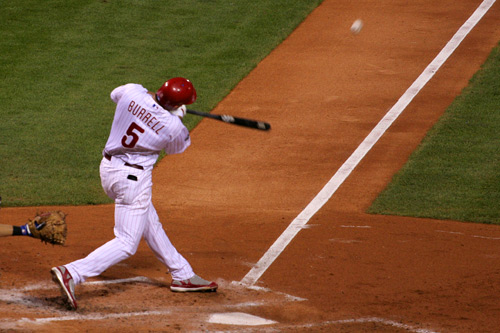
–B Love
PS: FYI, our Comcast Center section had itself a big update this weekend.
|
30 September 07: LET'S GO PHIL-LIES
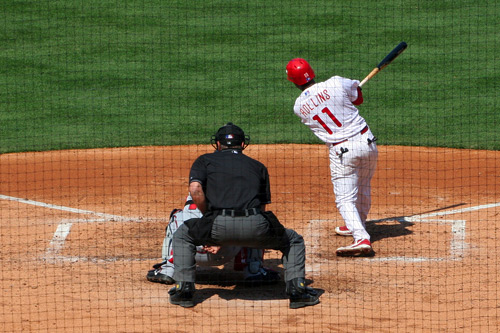
CLAP, CLAP, CLAPCLAPCLAP
–B Love
|
28 September 07: And so it's come to this
Three games left. Nationals @ Phillies. Marlins @ Mets. Who wants it more?
LET'S GO PHIL-LIES!
(High quality, high resolution photo courtesy of my POS phone.)
* * *
We're gonna take a much needed break today, but yr Skyline will be back in action this weekend.
–B Love
|
27 September 07:
This irresponsibility smells like a Septa tank
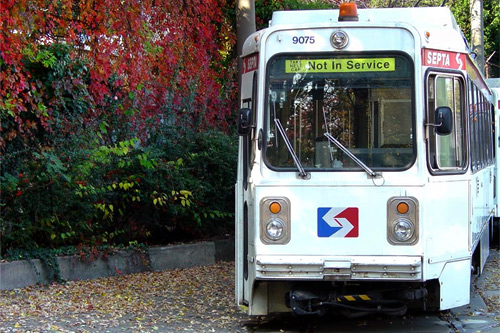
O Septa! My Septa! Our fearful trip is . . . well, just about every one we take.
Jess kiddin', Septa, riding you ain't so bad. You're good for a ride now and then, but you're hard to get is all. And a ride now and then . . . well, that's just not how you
play any more. These days, if you want a slice, you gotta buy the whole pie. (Yo Mark.) But Septa, darlin', that just ain't kosher. Not when we've had the relationship we've
had all these years.
See, it's always nice when we see each other -- moderation is the key. But now you wanna raise the stakes and play even harder to get? A little more buck for the bang?
Dollface, that's just a little irresponsible. I've got other rides to take, other choices to make.
All innuendo aside, that Septa is yet again considering raising its fares less than three months after the state granted it a $150M annual raise in PA money . . .
well, what word would YOU choose? Infuriating? Indecent? Inconsiderate? Asinine? They're all acceptable, and there are plenty more adjectives from which to choose.
Part of the reason for the raise was so that Septa wouldn't eliminate its transfers. It wanted to, the city sued so that they wouldn't, won, and Septa's transfers stayed. So
Septa strikes back by raising the fares on transfers and tokens, the cheaper options that poorer riders and casual riders like myself choose by necessity. Many a poorer
rider has a three-bus-transfer story, just like many a casual rider has a this-is-why-I-don't-ride-Septa horror story. My most recent one goes something like:
It's about 4 o'clock and I've had an uncharacteristically bad day, so I just need to blow off some steam. I head out the door, put on my headphones and call up
Seasons In The Abyss on the ipod. ("S'port the waaaaar!") I'm half a block from the Girard El station and a train passes by. Argh. Oh well, the extra time will allow
me to buy some tokens at Trax Deli. "Sorry, we're out of tokens." Drat. I walk up the stairs and ask the guy if I can buy two tokens. He taps his finger on the glass,
pointing at the sign that says "tokens not sold after 4". It's 4:15 now. I reach in my wallet to find a five and a single. As we know, a single ride fare is $2. I ask if he
can give me change for a five, knowing full well Septa employees don't do such a thing. He of course says no, right as I look through the booth at the stack of ones in
front of him. I plead with him (still politely at this point, mind you), saying that Trax was out of tokens and could he please work with me. By now, as you've surely
guessed, another train is coming as the third rail makes that sparking bumper-car sound. He's clearly irritated with me -- the irresponsible rider with neither a token
purchased in advance nor a pass purchased in advance -- and says "look, there's nothing I can do." Since I don't want to wait out another train, I throw the five
disgustedly through the slot and push the turnstile as angrily as possible, but still not hard enough to make it spin. It's a turnstile. It won't spin.
Yeah, I know the rules. The rules suck. If the rumors are true, a large majority of Septa's board members -- the ones who, at the moment of this post, are entertaining the
thought of raising token and transfer fares -- do not actually commute via Septa, but instead drive to work at 1234 Market. 1234 Market, the building directly on
top of the 13th Street el & trolley station and a quick concourse walk from both Market East and Suburban Stations. Again, that's just hearsay, but it's popular, believable
hearsay.
But there's no need to get mad at rumors when the list of substantive items to light your fire is so long.
Back in February, Septa said "fuck it" to upgrading its ticket machines to recognize and accept the "new" dollar bills and instead just boarded them up. At that time, yr
Philly Skyline opined, "hey, they've extended the hours of the always-pleasant sales windows, now open till 8 on the
weekend! That's pretty great for everyone traveling after 8, isn't it? A cursory glance at the R7 Sunday schedule shows four trains after 8pm. I'm sure that, since it's
Septa and all, they'll be considerate and waive the $2 surcharge for purchasing a ticket on the train." Ha ha.
As Paul Nussbaum reported in yesterday's
Inquirer, if you are at the station after cashier hours, or if you use a station that has no cashier . . . you're S-O-L, fool! Board at Crum Lynne, where the station is
not a station, but a lean-to with a Septa sign? That'll be two dollars extra. Working weekend hours on that case and finally ready to call it a night for the last train home
at 10? That'll be two dollars extra.
Says Nussbaum:Of SEPTA's 153 rail stations, 75 - including Tacony - have no ticket sales, and very few booths are open afternoons and weekends.
Expecting people to buy transpasses is irresponsible. Not everyone has money for a pass. Not everyone has need for a pass.
I've said this before, but why did Septa spend a million dollars to build a new el & trolley headhouse on the northwest corner of 30th & Market when there was already
a pedestrian tunnel that leads into 30th Street Station? Why? Because renovating it was too costly and the tunnel was too dangerous. Hooray, fear! Rather than clean up
the tunnel, add extra lighting and maybe some surveillance for safety (and to get really crazy, a guard), Septa decided it would be better to build an all-new headhouse
whose exit forces you to cross traffic comprised of taxi cabs and those who've just left the Schuylkill Expressway. 30th Street Station is intermodal
all right: el/trolley → car traffic → regional rail/Amtrak/NJT. The consolation is that we have Bridgewaters Pub, which stands on the very spot where the Station
end of the tunnel would exit. C'est la.
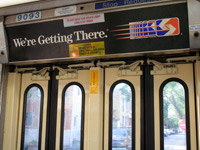 The whole manning-a-booth but not-selling-tokens and not-making-change thing described from firsthand experience above. Why? Why are you there? A machine can take two
dollar bills if I have them, and it can give me change for a five if I don't. What do you think all those Sacagawea dollars are for?
The whole manning-a-booth but not-selling-tokens and not-making-change thing described from firsthand experience above. Why? Why are you there? A machine can take two
dollar bills if I have them, and it can give me change for a five if I don't. What do you think all those Sacagawea dollars are for?
If Septa spent money on new ticket machines, and enough ticket machines to serve all its major stations (there are definitely none at Girard, and none that I can think of at
Pattison Ave -- the subway's terminus -- or City Hall, at the center of the city and directly under, well, City Hall, existing in the most squalid of subway
conditions), instead of things like new headhouses where tunnels already exist and trading
cards, it might not have to keep surly workers who don't make change on its payroll. Did I say that out loud?
As Phillip Tanfield reported in the September 5 City Paper, the El reconstruction
project is littered with problems: it's over budget, it's way behind schedule, it's adversely affected business under the el (despite Septa's promises that it would not),
and it's been unfair to minority contractors in a minority populated neighborhood. "Overall, the project has just been a really big mess," says Michael Nutter,
the Democratic candidate for mayor who served as that district's councilman. "There are always things that can be done better. However, with this project, I don't know much
of anything that can be done worse."
Don't take my word for it, take the already-popular next mayor's.
The trains, in a sense, encourage drinking and driving. Oh, that's nonsense? Then why don't they run later, if no other time than on the weekends? This just in: people
drink! This also just in: Center City Philadelphia has lots and lots of places who operate on the sole premise of . . . drinking! And they stay open until 2 in the morning to
facilitate, nay, encourage this drinking.
Let us theorize that Old City is a place where people from the suburbs like to drink. Suburbanites on the Pennsylvania side can take any of Septa's regional rail lines into
Market East station and either walk, take the el, or catch a cab down to 2nd Street. Jersey burbers can take Patco. Weekend departure time of some of the more popular
outbound Septa RR lines? How's this grab ya?
• Last R2 to Wilmington: 7:34pm(!), last R2 to Marcus Hook: 10:25pm.
• Last R5 to Malvern/Thorndale: 12:12am
• Last R5 to Lansdale/Doylestown: 11:20pm
• Last R6 to Manayunk/Conshohocken/Norristown: 11:25pm
• Last R7 to Trenton/NYC: 11:05pm
• Last R7 FROM Trenton/NYC: 12:47pm
The Patco posse heading back to Jersey? They'll just wait for the next train at 8th & Market, since they run ALL NIGHT every 20-40 minutes.
Again, this is all theoretical, on the crazy and wild idea that some people like to go out on the weekends with the intent to get drunk; far fetched, I understand.
Let us also . . . hypothesize (or as Steve Seese once said, hypotenize) that Northern Liberties is a place where young folks from around the city like to drink. Well,
stinky, suck down all the swill you can by midnight, because in the midnight hour the el and the subway shut down. Oh, there's a night owl bus that runs the same route? My
bad. Everyone loves to ride an overnight bus in the city of Philadelphia.
Comparably speaking, here are the options our northeastern megalopolitan drunken brethren are presented, in lieu of driving home drunk:
• BOSTON: Last train on the T (red, blue, orange, green, silver lines): 12-12:30am. Last train on the commuter rail lines: in the 11 o'clock hour, for the ones with
service. (Some lines don't operate on the weekends.)
• NEW YORK: Should we even bother with this? The subways run all night. The 2 train runs from the top of The Bronx all the way to Flatbush Brooklyn, the A train runs
from Inwood Manhattan to Far Rockaway Queens, and even the G train runs only from Brooklyn to Queens, and they all . . . run all night. The Staten Island Ferry and
Staten Island Railroad? They also run all night. Long Island Railroad trains, on the other hand, stop running out of Penn Station, on average, around 1am. But then,
considering the bars in NYC stay open till 4, you could have a late go of it, hit an all-night diner, then just catch the first train out in the 5am hour.
• NEW JERSEY: Oh New Jersey Transit, how do you keep your entire state connected and stay in the black? Oh. Well, I guess it's not from late night trains, since the
last outbound trains leave Penn Station on the NEC (Trenton) and Bergen County lines at 1:41am. That's still not horrible.
• BALTIMORE: Last Metro (subway/el from Johns Hopkins to Owings Mills) leaves downtown at midnight. Last light rail (Cromwell to Hunt Valley) leaves downtown at
roughly 1am. Not great, not bad. It's pretty good for Baltimore, which has the same last call as Philly.
• DC: Last outbound Metro trains leave just before 3am.
So, given the options, Septa's not the worst of the bunch, but seeing that list sure justifies frustration.
Eh, why go on?
The system is clearly broken, and everyone but Septa itself knows it. Or, well, they're aware of it, but the current captains don't appear to be able to right the
ship.
These are one person's opinions, but I don't think I'm exactly in exclusive company. I, like everyone else who can agree on the basic premise that Septa Is Broken,
want Septa to succeed and expand and be well used and well served. I want to like Septa. But it's so hard to, in spite of the genuinely good drivers and funny
moments you happen upon. That's why the current state of transit in this city is so damn frustrating.
* * *
For more Philly Skyline thoughts on Septa, scroll down two stories to "Fare Catch" by Steve Ives, or pick up the latest City Paper, in which you can sample Nathaniel
Popkin's parallels between Septa GM Faye Moore and President George W Bush. Or better, read it online HERE.
* * *
For further reading still, check out the fantastic and frequently updated Septa Watch. Now if you'll excuse me,
I've got a Septa El train to catch.
|
  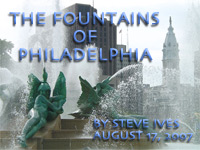 
26 September 07:
I'm still in love with you . . . on this Harvest Moon
26 September 07: Quickie Humpdate from across the River
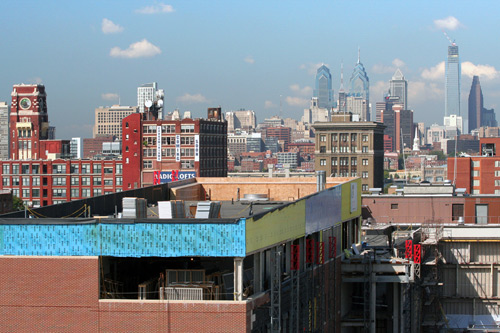
And now, instead of Geoff Geary rant #56, a Philly Skyline Philly Skyline for our friends over in Camden.
The view from the Camden riverfront has always been one of its biggest attractions in a list which includes real live tangible attractions like an aquarium, a minor league
ballpark, a warship, a marina and a concert amphitheater. The view of the Ben Franklin Bridge and the Philly Skyline with the Delaware River foreground are popular
favorites (Sand in the Vaseline).
But to add a little depth and a lot of context, you have to go inland a few blocks, past the oceans of asphalt parking lots . . . see Camden from slightly above,
take in what's left of its industry -- RCA's buildings which have been and are being converted to condos, the Ballpark, Rutgers University's growing presence . . . that last
one is the construction you see in the foreground of this photo. Rutgers' School of Law is
undergoing a $24M expansion designed by Ayers Saint Gross Architects that will open next year.
Go on 'head, Camden.
Wouldn't it be nice if the Phillies took the Riversharks into their farm system? I mean no disrespect to the fine people of Lakewood, New Jersey, but the Philadelphia
affiliation seems marginal at best, and once the AAA team moves to Allentown, the entire Phillies farm system will be regional (with the exception of Clearwater, where the
spring training facility and situation has always been just about perfect). Campbell's Field is a gorgeous ballpark with an unmatched view -- give me one other stadium that
has a 400' bridge standing in its outfield -- it would be a great city-to-city gesture, and it would lend a little cred to the baseball being played across the river. The
independent Atlantic League is entertaining and all, but with no ties to any Major League teams, the best you're going to get is Cigar & Scotch Night and the prospect of a
former Major Leaguer going batshit and attacking a pitcher and catcher on film in front of a thousand fans and then pleading not guilty to charges of the same.
Come on Phillies. Throw Camden a bone. Ditch Lakewood and give the organization a home right across the Delaware.
–B Love
|
25 September 07: Fare Catch
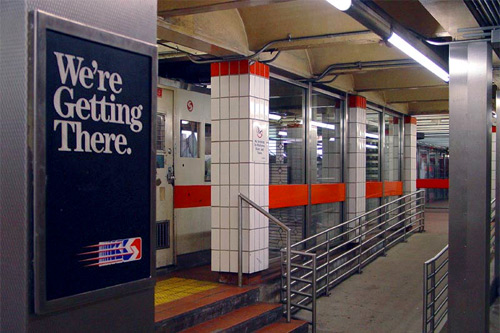
by Steve Ives
The first thing everyone learns in eighth grade algebra is that the equation, no matter what, must be balanced. What happens to one side of the equation, somehow or someway,
must happen to the other.
This past summer was a rollercoaster for mass transit users in Philadelphia and it seemed that after the circus of fare hikes and dependable funding came to an end, we were
finally at a time of peace in the never-ending SEPTA saga. Crisis averted. The state steps up. Equation balanced.
Right?
Wrong.
Then they started talking about transfers.
The transfer, that nifty little 60 cent throwback to grade school writing paper, is representative of the biggest problems The Authority is dealing with and at the heart of
this new issue.
We're all familiar with SEPTA's valid argument that the paper transfer is outdated, it's clunky and not the most efficient means of getting people from one vehicle to
another. And we're also familiar with the old yarn about SEPTA always "looking into" or "examining options" for updated fare collection, as if no other system on Earth has
ever attempted it or done so in a timeframe that would give SEPTA plenty of opportunity to study. They are correct -- the transfer needs to be done away with but the manner
in which they set about doing it was the problem.
Eliminating one system based on its obsolescence without installing its updated replacement is, as Common Pleas Court Judge
Gary DiVito argued, "capricious." It is a complete disregard for the realities of its token using riders. No system of SEPTA's size, with the exception of Boston, charges
riders who use the equivalent of a token another full fare on a transfer.
And this would be an act not without precedent. In January of 2007, SEPTA eliminated ticket vending
machines from its Regional Rail stations, forcing riders to purchase tickets directly from cashiers (the variety that does make change, curiously) or purchasing a
TrailPass. This was just as brutal a blow as the effort to knock off the transfer -- make it a bit harder for people who are paying a bit less. It doesn't seem to occur to
anyone at 1234 Market that people can use the system frequently but not five round trips a week. It doesn't seem to occur to them that passes are not the best value for
everybody. And it doesn't seem to occur to them that eliminating their current systems while playing the waiting game on their new ones hurts customers and their already
rancid reputation.
Though I do think a comparison is fair. What do people in other cities pay so much for that we're getting practically for free in Philadelphia? Let's look at the other big
systems:
| City/System
| Discounted Fare (Bus to subway)
| Transfer
| Philadelphia (SEPTA)
| Token: $1.30
| Paper transfer: 60 cents
| New York (MTA):
| Single Ride MetroCard: $2.
| Within two hours, included in cost
| Chicago (CTA):
| ChicagoCard: $1.75
| Extra 25 cents gets you *two* transfers
| Boston (MBTA):
| Charlie Ticket: $2.00
| None: Full fare *plus* 25 cent surcharge
| San Francisco (Muni)
| None, $1.50 fare
| Free: mandatory paper transfer
| Washington (WMATA):
| Token: $1.25
| None (rail fares are not "fixed")
subway to bus transfers: 35 cents
| | | | | | |
As you can see, SEPTA is not as far behind the curve as it seems. Even though our current system is practically Paleolithic, it's relatively efficient and within the same
price range as the other systems -- at least until the increase.
So what's the advantage to the new system? What's so wrong with the current setup? It does exactly what SEPTA says it does -- it streamlines things. It makes life easier,
for a change, for its riders. Imagine the convenience of being able to purchase a pass or farecard right where you are. Imagine being able to buy a farecard at 46th Street at
8pm on a Sunday night . . . with your credit card. Imagine this oft-maligned agency has the right idea for once.
The current decision to raise token and transfer prices is a happy medium. The best anyone seems to be able to do right now. Transfers are still available -- you'll just pay
more (ask me and my fellow TransPass holders how happy the extra $2 made us feel). Tokens are still available -- you'll just pay more.
While we endure the confusion SEPTA creates by getting to the right place the wrong way we'll all sit and wait for them to stop balancing the equation and just give up the
answer.
–Steve Ives
phillytrax@aol.com
For Steve Ives archives, please see HERE.
|
25 September 07: The Philly Skyline Book Review:
Forgotten Philadelphia, Lost Architecture
Of the Quaker City by Thomas H. Keels
|
Forgotten Philadelphia: Lost Architecture of the Quaker City, by Thomas H. Keels
Temple University Press, 2007, 320 pages
Reviewed by Nathaniel Popkin
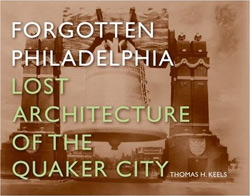 I spent some time in the Northern Liberties this week, walking some of the narrow streets and alleyways between Third and Fifth Streets for the first time in a while. It
still feels just a little like a lost world: amidst the dozens of wildly disparate and somewhat overblown new row houses morning glories climb the signposts and cats dart
and late season begonias -- their leaves parched and therefore the color of sea glass, their flowers drained to barely pink and yellow speckled -- linger on, insistent and
therefore ravishing. Giant Paulownia leaves are underfoot -- they've landed on a patch of luminescent blue brick paving, that strange bejeweled -- glazed, certainly --
cobblestone you find also on the 1400 block of Addison Street. Out beyond are weeds, frogs, I imagine the rusting carcass of a Citroën -- maybe in five years all this
will be gone, this land of Indians and settlers, barkeeps and smelters, paved back and properly tamed. If you've lived for a while on St. John Neumann or Orianna or Myrtle
or Leithgow it must be unsettling to watch the charm disappear.
I spent some time in the Northern Liberties this week, walking some of the narrow streets and alleyways between Third and Fifth Streets for the first time in a while. It
still feels just a little like a lost world: amidst the dozens of wildly disparate and somewhat overblown new row houses morning glories climb the signposts and cats dart
and late season begonias -- their leaves parched and therefore the color of sea glass, their flowers drained to barely pink and yellow speckled -- linger on, insistent and
therefore ravishing. Giant Paulownia leaves are underfoot -- they've landed on a patch of luminescent blue brick paving, that strange bejeweled -- glazed, certainly --
cobblestone you find also on the 1400 block of Addison Street. Out beyond are weeds, frogs, I imagine the rusting carcass of a Citroën -- maybe in five years all this
will be gone, this land of Indians and settlers, barkeeps and smelters, paved back and properly tamed. If you've lived for a while on St. John Neumann or Orianna or Myrtle
or Leithgow it must be unsettling to watch the charm disappear.
I stopped by the new offices of Erdy-McHenry Architecture, in a blank-walled former auto-body shop, until last year filled floor to ceiling with cars and parts. Their touch
is deft, solid, sure -- and now the vaulted space makes you feel as if it had always wished to be the atelier of some serious-minded architect. On Lawrence Street, with its
run of nearly-perfect worker housing between St. John Neumann and George, I visited with Karl Olsen, the painter and former blacksmith, who with his wife Sara, herself a
metal-worker, turned a former diaper factory into a house, courtyard, and studio. The steel trusses from the old industrial roof still fly over head; a bitchy rabbit hops
along underfoot; grape vines and wisteria battle for territory. Karl took me down the block to meet Sal and Duncan Buell, who occupy a three-story former horse barn.
Duncan made me coffee and I sat in the magnificence of their living room. Sal opened the double barn doors and there danced the gold dome of the Ukrainian cathedral just
beyond, and I listened intently to their stories -- of Sal's '67 Beetle, of the raceway at Philadelphia Park, of Duncan's exhausting, exhilarating time working for Louis
Kahn.
For the third time in a just a few days, I was moved by this extraordinary act of adaptation. What it means to be a Philadelphian is to live, without quite obliterating it,
inside someone else's dream. Karl does -- his courtyard with Sara's tall red cannas is dotted with the remains of that old factory; its door is his. Most of us have to
walk through someone else's door -- which is why it makes sense to begin a conversation on the Possible City with a review of a book called Forgotten Philadelphia.
I'm not advising we start by looking back, merely acknowledging that by isolating the tension between the weight of the past and the vital imperative to move forward, this
book by the writer Thomas Keels is valuable, fascinating, and prescient. Indeed, Keels isn't reveling in some mythic past. Rather he's describing the power of the desire
to build anew: how it forms, spreads, wins out -- or often enough gets lost, compromised, or forgotten. Along with histories and pictures of some 200 Philadelphia buildings
torn down, Keels leaves us with a chapter on "Projected Philadelphia," in which he imagines, you guessed it, the Possible City. (Keels revels too in Louis Kahn, calling
this imagined place the "City of Availabilities.")
The more I write about Philadelphia, the more I'm stuck by the depth, love, and expertise of her bards. Keels, like Beth Kephart, the author of Flow, the lyrical
autobiography of the Schuylkill, and Gary Nash, who wrote 2002's First City, has found a new way to rekindle this city's history without telling straightforward
historical narrative. (First City is the history of how history has been told -- and an invaluable cultural resource.) Though it is a beautifully-produced, visually
elegant work, Forgotten Philadelphia's strength is its narrative awareness -- this is a painstakingly-researched book to read through.
Keels introduces the reader to the tension inherent in the changing city by telling us the story of the 1952 demolition of Frank Furness' Broad Street Station. Through this
one telling example we come to immediately understand the writer's handle on the thrill and melancholy of demolition.
Even though an agreement to demolish Broad Street Station had been in place since 1925, the destruction of the building (postponed by the Depression and World
War II) took countless Philadelphians by surprise, much like the death of an elderly but vital aunt whom one had assumed would live forever. Philadelphians' sorrow
transcended the loss of a familiar, lifelong locale, the scene of countless memorable meetings, arrivals, and departures.
Keels goes on to mete out the politics, economics, and cultural significance of the $157,500 demolition of the nation's busiest train terminal, grief versus faith, a pattern
he says has been repeated throughout the city's history. A minor critique I have is the way Keels, so fond of the clarity of this tension, uses the rest of the introduction
to sell the idea of his book. Some of it sounds like it came straight out of the pitch he used to find a publisher.
But once the author gets into his subject-matter, the reader feels as if he is in good hands. From the circa 1666 Swedish block house -- "common Scandinavian structure" --
to the old Liberty Bell Pavilion, Keels demonstrates the thoroughness of his research. Here, with incisive detail and a firm understanding of natural history, he tells us
about the Blue Anchor Tavern, built circa 1682 (perhaps 1671), demolished 1828.
Besides being "Victualler and Tappers of strong drink" with sturgeon and sea turtle on its menu, the Blue Anchor became Philadelphia's commercial exchange and
transportation hub. Watson called the tavern "the proper key of the city, to which all new-comers resorted." At the Blue anchor, goods were traded from all ships anchored
in the Dock. Ferries carried passengers to New Jersey, to Windmill Island where a windmill ground their grain, and across Dock Street to Society Hill. Farmers tied their
boats to the tree lining the Swamp and sold their produce to local housewives.
A 1691 citizen's petition asking that the Blue Anchor's landing be made a free harbor signified its pivotal role in early Philadelphia. Penn obliged by designating the Blue
Anchor wharf one of two permanent landings in his 1701 city charter. By this time, unfortunately, Dock Creek was changing from open water to an open sewer, polluted by the
waste of nearby tanneries, lumberyards, and slaughterhouses. (Between 1767 and 1784 the entire creek was covered over to create Dock Street.)
Keels enjoys telling us about the rudimentary, curious, ornate, misunderstood, absurd -- the book's candy -- and so we have cave dwellings along Front Street, the unused
Presidential Mansion, the Marble Arcade, Moyamensing Prison, the Phil-Ellena mansion, Jayne's, Kiralfy's Alhambra Palace, the Floating Church of the Redeemer ("Even the most
zealous missionary, however, has to concede the logistical difficulties of a floating church."), the Forum of the Founders, the Bulletin Building, and Lubinville, Siegmund
Lubin's groundbreaking movie studio at 20th and Indiana.
But the meat is the ideas implicit in the design and demolition of all these structures. Take, for example, the Arcade Building, built by Frank Furness to mimic Milan's
Galleria Vittorio Emanuele. Keels tells us the spatial problem the owner of the building, Alexander Cassatt, needed to address, the design compromise that resulted in a
"monumental portal," and the building's ultimate aging, falling out of taste, and demolition, in 1969. "Modern Philadelphians," Keels says in the introduction, "wonder how
their forefathers could have been so shortsighted or self-centered as to permit the loss of such relics." Keels tells us why: the Arcade Building was demolished to create
Dilworth Plaza, the vast public space just west of City Hall. While Dilworth Plaza has never been properly used and in its turn is glaringly ready for demolition, can you
argue with the instinct to give City Hall a foreground?
The essay on Tasker Homes, built in 1940 and demolished in 2001, is a telling example of how ideas get twisted in reality. The project was designed in the International
Style, loaded with intentional design elements such as community-building courtyards, a community center, square and school (Audenried), all rationally distributed
throughout. Though essentially treeless when it opened, the units were a modern respite from the Depression. And yet this relatively ground-breaking development quickly
fell out of favor and into chaos and disrepair. The Schuylkill Expressway, racism, and the erosion of the public sector effectively battered the ideals so that when it came
down six years ago a great sign of relief was heard across the city.
Intent, ideas, hope: perhaps these count for something, but the great melancholy of this book is the recognition of wasted energy, the sorrow of dreams washed away. This is
no more so than in the section on Projected Philadelphia. Here is the reminder that we've all been here before, attempting to reform and reinvent this city. Are we too
destined to destroy what we ought to save, discard what we ought to build? How do we plan not just for today but for the city of tomorrow? (Keels reminds the reader of the
difficulty even in projecting population -- that in the 1950s, planners were imagining a city of three million, not half that.) A reasonable place to start might be with
ideas that seem to endure, demolition or not. The three I keep coming back to -- they vary in scale and ambition -- the role of exuberant architecture, the need for even
temporary structures for play and recreation, and the scale of ambition. We still wish to make our mark. Keels quotes the architectural historian George Tatum, "Because
they were not afraid of new ideas, whether in the field of politics, social reform, or the arts, Philadelphians were among the first to try new architectural forms and
theories. They produced the most advanced hospitals, the most progressive prisons, several of the most ambitious churches, and some of the earliest and most beautiful
municipal parks. Their bridges were longer, wider, and deeper than others of their day."
–Nathaniel Popkin
nathaniel.popkin@gmail.com
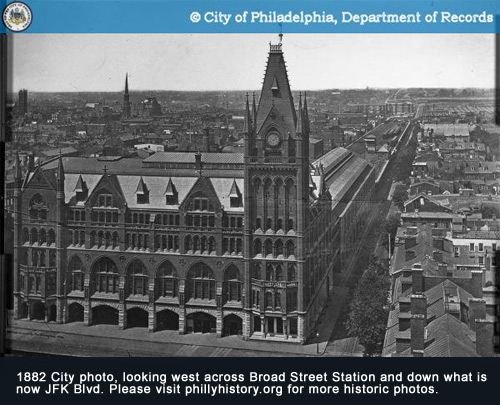
* * *
Tom Keels appears at Borders Bookstore at Broad & Chestnut tonight (Tuesday, September 25), and then on Wednesday, November 9 to sign and discuss Forgotten
Philadelphia.
For more on Forgotten Philadelphia, visit your local book shop -- how about Joseph Fox Book Shop or Robin's Bookstore? |
24 September 07: A Philadelphian in the Capitol
|
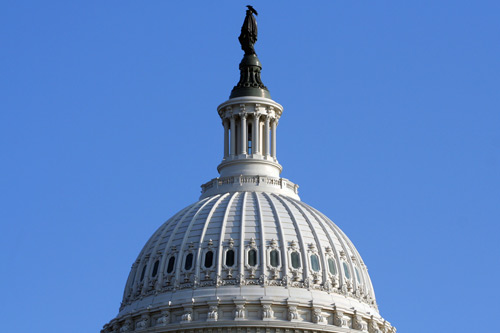
Capital is the town/city in which the seat of government resides. (Capital is also the spelling for pretty much every designation of the word: capital letter,
capital investment, capital punishment, et cetera.) Capitol is the building in which that government governs. It's why I've always wondered which designation the
Pennsylvania Turnpike Commission is going for at the Harrisburg East exit, where the sign reads "Harrisburg, State Capital". Most people already know that Harrisburg is the
state capital, so is it just a friendly reminder? Or is it a typo and they really mean State Capitol? Or are they being cheeky and saying "this is where your state capital
($) resides"?
Down in DC, another fine Philly day trip away, the US Capitol stands as perhaps the most recognizable building in the country, and what makes it recognizable is purely
Philadelphian. The Capitol of course goes as far back as the 1790s, when Philadelphia served its term as capital, knowing that land along the Potomac River was
selected and being turned into a capital city, rather than a city that hosted a capital. A design competition suggested by Secretary of State Thomas Jefferson was held and
seventeen entries were submitted.
None of the 17 plans submitted, however, was wholly satisfactory. (AOC.gov)
President George Washington subsequently approved an entry submitted after the competition by William Thornton. The cornerstone was laid in 1793, and construction was
overseen by a number of architects over a number of decades, through sicknesses and wars and changes to the design, including new wings overseen by Benjamin Henry Latrobe
and a dome by Charles Bulfinch.
It was in the 1850s, though, that the Capitol as we know it came to be. Though the Capitol already was a massive landmark, it could not accommodate the growing numbers of
senators and congressmen and their staffs as the country kept adding states, so President Millard Fillmore held a competition to expand the Capitol.
Philadelphia's Thomas Ustick Walter was riding the peak of his career, having recently finished planning the Girard College for Orphans, the Greek Revival main building (now
known as Founders Hall) serving as its icon. Walter studied under William Strickland and was a founder of the American Institute of Architects. His résumé
earned him commissions as far away as Venezuela and Shanghai. Prior to Girard College, Walter's greatest success in Philadelphia was the Moyamensing Prison "in the country" at 10th &
Passyunk, where Ac-a-me and its parking lot stand now. Late in his career, he was second in command to John MacArthur for Philadelphia City Hall, and watched over its
construction until his death in 1887 (14 years before City Hall opened its doors).
But his most famous achievement is without a doubt his work at the US Capitol. President Fillmore selected Walter's expansion that included enormous wings on the north and
south sides of the existing building. As construction carried out, the new length of the building left Bulfinch's earlier dome a little emasculated. Bulfinch's was also only
a copper top to the wooden dome of a building which had had several fires. Walter proposed a grand, cast iron (and fireproof) dome with a statue on top. Congress approved
Walter's dome in 1855, Bulfinch's was deconstructed in 1856, and the current dome was built over the next several years, culminating in a gun salute after the Statue of
Freedom, a 19' sculpture by Thomas Crawford, was placed at the height of the Civil War in late 1863.
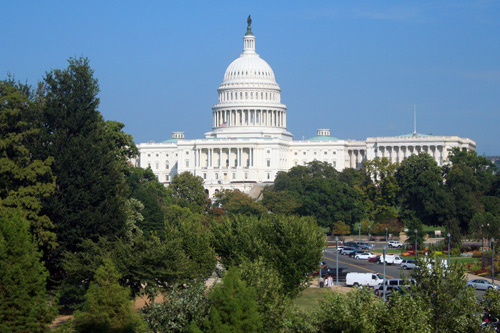
The dome was complete, but the extensions continued beyond 1865, after the Civil War was over and after Walter had resigned his post over a contract dispute. Since that
time, the Capitol has undertaken innumerable renovations, changes and expansions. As we speak, a Capitol Visitor Center is being built under the supervision of Alan Hantman,
the current Architect of the Capitol, a post so coveted it gets its own .gov web site: aoc.gov.
Thomas Ustick Walter is just one in Philadelphia's long lineage of important architects, but he's significant enough that the Athenaeum held a dedicated exhibition of his
work in 2004. It is archived HERE, and his general profile is on the Athenaeum's PAB site HERE.
* * *
And a capital time was had by all down DC way. Amtrak's a nice way to travel the northeast corridor, there's no doubt about it. But don't you just wish that MARC and Septa
could sit down for some talks about extending MARC's service from Perryville MD to Newark DE? It's a measly 21 miles, and the hard part -- crossing the Susquehanna -- is
already done. If MARC could just push itself to Newark, Philadelphians (and northeasterners and international travelers) could have a rail option other than the
much-more-expensive Amtrak, similar to the Septa-NJT option so many of us take to New York.
The Phillies looked good in all three games against the Nationals, but the bullpen went ahead and figured that the Nats should have a win as they closed out RFK Stadium.
Nationals fans -- all six of them -- thank you, Antonio Alfonseca and Kane Davis. It's not like the Phils need every single win they can get in the thick of this playoff
chase or anything. The good news is that they're at home from here out, with three against the Braves and three against those same Nationals. LET'S GO PHILLIES.
But just for this once, here's a little nod to a dying breed, the big bowl multi-purpose stadium. The Nats open their new ballpark just downstream on the Anacostia River in
April, and that alone will presumably ignite baseball fever in DC. If the Nats can sign some talent, the Phils will very well have themselves a formidable new rival. For
now, rest in peace Bobby Kennedy, and rest in peace baseball at Bobby Kennedy's stadium.
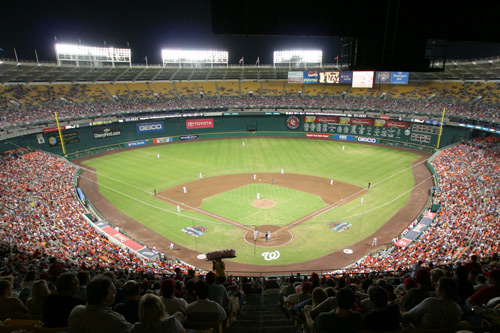
* * *
Comcast Center, Murano and Residences at the Ritz-Carlton
all got themselves a nice "it's autumn baby, may the air be cool and the foliage rule" update, so have a look-see if you haven't recently.
One other Calendar of Events reminder (okay, two): 1, tomorrow night is the Ed Bacon Better Philadelphia Exhibit event at the DVRPC, details HERE. 2, Wednesday night -- the harvest moon -- the Rittenhouse Astronomical Society is
hosting Robert Nemiroff, the editor and lead contributor of NASA's incredible APOD (Astronomy Picture of the Day) web site, as he promotes his new book Astronomy: 365 Days.
Finally, one other reminder that your ideas, suggestions and proposals are still welcome for the Port Richmond Conrail yards, and for Nathaniel Popkin's Possible
City. They're the subjects of the two posts immediately beneath this one, so ch-ch-check em out.
–B Love
|
   
21 September 07: Here is the Possible City
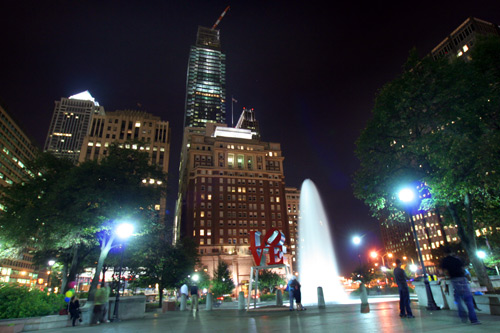
by Nathaniel Popkin
September 21, 2007
Imagine just how many Philadelphias there are, how many ideas, renderings, concepts, capstones, thesis projects, studio designs, abstract scribbles, master plans, renewal
plans, redevelopment plans, green plans, sustainability strategies, waterfront designs, how many dreams and ideas have been projected at scale across a plotted map of this
city -- and therefore just how many possible cities there are. Louis Kahn alone probably could have filled the entire 1:1 scale 135 square miles with Availabilities,
Rooms, Courts, Forums, Civic Centers, and Inspirations neatly drawn and never built, only to exist as a tacked-up nether-world, a colossal, ever-growing what
might-have-been with a steady population and plastic bags that don't swirl ceaselessly in the wind. I imagine that for many architects and planners, these possible cities
blur the line between reality and the imagination. Anthologies of Kahn's work are replete with the unbuilt, elaborate exercises in dreaming that seem almost
indistinguishable from the things of permanence that were erected in due order.
It may be that all cities require people to dream, but in Philadelphia imagining a new city is the singular act of citizenship. We're all of us ever-wondering what might
be. We dream so intensely because we see the glowing possibility. It's just right there. The potential is marvelous, the possible only limited by our own imagination.
This feeling has much to do with the historical moment. Old cities like ours have completed the cycle: growth, industrialization, immigration, decentralization,
deindustrialization, sprawl, and suburbanization. The U.S. is today all but completely suburban: merely 6% of Americans live in densely-populated cities. Meanwhile, the
world of cities is changing more rapidly than even the glaciers are melting. Mike Davis introduces his seminal Planet of Slums, "In 1950 there were 86 cities in
the world with a population of more than one million; today there are 400, and by 2015 there will be at least 550." What's a Philadelphia in a world of Hefei, Xintai,
Jamshedpur, Asansol, Karaj, and Taegu?
Precisely because we've come to this end of archetype the answer is anything we want it to be. There has been a tangible shift in expectation. The anti-casino movement
has given us a new buzz-word: transparency. The necessity to address global warming has given us another: sustainability, this one packed with the fertile loam of a
million new utopias. And, wonder of wonders, the certain election of Michael Nutter has us believing that something might come of it.
It's important to recognize that the act of dreaming isn't the act of building; nor, even under the best circumstances, do the vast majority of dreams come to reality.
But it is worth remembering that for every Mary Brown, long-time West Philadelphia neighborhood organizer whose sensible hopes for 52nd Street were ultimately plowed under
by the brutal disorder of poverty and inadequate public investment, there is Shane Claiborne, the visionary I wrote about in last week's City Paper, whose singular sprit has infected the blocks around Kensington and
Allegheny. (Ed. note: we'll revisit Shane and the K & A situation here next week.) For every Foxwoods there is Cedar Park, the pizza slice of public space just
east of 52nd Street that was lovingly rebuilt last year after the completion of a well-honed process of community design.
In his 1961 classic The City in History, Louis Mumford included a wonderful essay within a larger chapter on medieval cities, "Venice Versus Utopia." In it,
Mumford pits the accumulated and yet singular genius of Venice against the fictional Utopia of Thomas More. By placing these two city forms in direct contrast, we are
given a new paradigm of contemporary Philadelphia. Venice, Mumford says, "was no static design, embodying the needs of a single generation, arbitrarily ruling out the
possibilities of growth, re-adaptation, change: rather, here was continuity in change, and unity emerging from complex order." Piazza San Marco, in particular, is "the
product of cumulative urban purposes, modified by circumstance, function, and time: organic products that no human genius could produce in a few months over a drafting
board." This is -- perhaps without certain aspects of genius and unity -- an apt description of our city today. (It's certainly the Philadelphia I describe in Song of the City.)
All this compares rather instructively with the Utopia of 1516 -- the place that was in so many ways the intended model for Philadelphia. What strikes Mumford about
Amaurote (Amaurote is one of 54 identical cities on the island of Utopia) is the uniform spatial design, allowing for the optimal personal connection to a garden, the
raising of food, and the great outdoors, and democracy -- of government as well as work: all the elements of rational planning that came to infect William Penn and which
we still struggle with today. "Every house has both a street door and a garden door; indeed their zeal for gardening 'is increased not merely by the pleasure afforded
them, but by keen competition between streets, which shall have the best kept gardens.'" Does this not sound like the aspiration of Philadelphia Green?
"But who would exchange Venice for the dreary regimentation of and uniformity of Amaurote?" Mumford asks. "And yet who would exchange the civic decencies of Amaurote for
the secretive tyranny, the festering suspicions and hatreds, the assassinations of character, the felonious assaults and murders that underlay the prosperous trade and the
festive art of Venice?"
Is this not the question we are faced with today? How much relative weight should we give to the gradual, "bottom-up," incremental change we've become so used to -- and
dependent on, with neighborhood groups not only doing the planning but providing services. How much of the heavy-hand of City Hall do we want, or need?
Harris Steinberg, whose PennPraxis is completing the plan for the Delaware waterfront, says that the day has returned for Philadelphia to use its power of eminent domain,
in order to re-install the grid between Front Street and the river. That means declaring that it's time for the incremental, mostly private, and wholly uncoordinated --
the Venice in this typology -- to give way to clear ideas, much of which are based on the principals asserted by the utopian William Penn. The Praxis plan creates a
uniform grid and a pattern of greenspace. It hopes to reassert the Philadelphian's connection to her river while creating regular, valuable parcels for development. In
other words, Steinberg urges a single strike for Utopia in order to seed a new, as yet unformed Venice.
1961: Kennedy, the Bay of Pigs, Mumford's tome appeared, and also, amazingly, Jane Jacobs' classic The Death and Life of Great American Cities. Jacobs' book is
still the urban planner's bible; nearly every value we ascribe to our city's resurgent urbanism was articulated there -- so effectively and with so much foresight that the
lives of a thousand citi-philes with writerly ambition have been forestalled. Why? Nothing else to say. We all speak Jacobs' language. Inga Saffron does -- her recent
critique of
the Broad Street façade of the Convention Center is case in point. Here in Bella Vista, neighbors who come to duke it out in front of the Town Watch's zoning
committee are fighting all over again for or against mixing uses, diversity of building types and heights, the role of the sidewalk, density of people, and the subjugation
of everything to the automobile. When someone stands up at one of these meetings (sometimes it is me) and says, "We know what makes cities great," and someone else rises
and says, "But this is a residential neighborhood and we don't want the noise," they are taking part in a discussion perfectly framed forty-six years ago. It hasn't
gotten boring yet.
But rancor emerges in neighborhood debate -- the clashes of dreams, no? -- because we citizens are expected to dream and decide all at once. This is policy nowadays, the
perfectly rational response to the disastrous age of rational planning. The Philadelphia architect-activist Al Levy says, "Very early in my career as an architect it
became obvious to me that the real decisions about what our homes and our neighborhoods were like had to be made by the people who lived in them and by our communities. I
had worked with many community groups around the city eager to improve their environment and it was very clear that most of the people involved in these groups thought
that it was the professionals, the architects and planners, who made these decisions."
Al, who is one of the unsung heroes of this resilient city, is right: people ought to determine the future of their neighborhoods. Does that mean City Hall should
retreat, answer only to the wishes of neighbors? What happens when there are clashing dreams?
My friend Rich Schragger, who is a professor of local government at Virginia Law School, says that the lesson of Jacobs doesn't come from 1961, but 1970 and 1984 when in
The Economy of Cities and Cities and the Wealth of Nations she declares that cities, almost alone, are the economic engines of the world. World trade is
city-to-city trade, nothing else in the history of civilization compares. Schragger says that means American cities need to reassert their power in the marketplace, doing
so in part by exploiting the gray area of law that exists in our federal system. In other words, Philadelphia mustn't simply retreat behind the noise of community-based
debate, but rather set policy that is responsive to -- but isn't necessarily beholden to -- neighborhood wishes. A new zoning policy that takes some control away from
residents and district councilmen in order to apply 1961 Jacobsian principals is case in point.
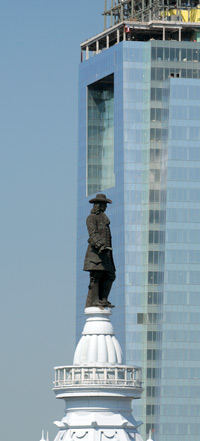 My intention these next few months is to very informally use Mumford's and Jacobs' framework to help us think through some of the critical questions of city planning that
face Philadelphia today. I'll talk with some of the most visionary members of the community -- artists, architects, community activists, planners, historians, experts in
local government, gardeners no doubt, and so many others living and dead -- as I posit the Possible City. I'm going to cover the territory -- from integrating physical
and mental healthcare into the landscape of planning to revisiting Louis Kahn's enduring idea of the Availabilities. I'll rethink transportation, personal identity, and
pageantry while lending credence to concepts like legibility -- with the hope that certain things can and ought to be done to make it easier to see and understand the
city. I'll try to figure out if internal economic networks, such as the Sustainable Business Network, can provide economic stability and serve as a model for the Possible
City.
My intention these next few months is to very informally use Mumford's and Jacobs' framework to help us think through some of the critical questions of city planning that
face Philadelphia today. I'll talk with some of the most visionary members of the community -- artists, architects, community activists, planners, historians, experts in
local government, gardeners no doubt, and so many others living and dead -- as I posit the Possible City. I'm going to cover the territory -- from integrating physical
and mental healthcare into the landscape of planning to revisiting Louis Kahn's enduring idea of the Availabilities. I'll rethink transportation, personal identity, and
pageantry while lending credence to concepts like legibility -- with the hope that certain things can and ought to be done to make it easier to see and understand the
city. I'll try to figure out if internal economic networks, such as the Sustainable Business Network, can provide economic stability and serve as a model for the Possible
City.
It's worth noting this week's announcement by the city of San Francisco that it will guarantee healthcare to all citizens. This, according to Schragger, is just the way
cities ought to assert their power. With that as our template, I'll imagine ways Philadelphia can be a stronger corporate body, capable of acting beyond the current
limits imposed by Pennsylvania that now throttle local initiative. (Gun laws are one obvious case-in-point.)
A related exercise, certainly, will be to think about how much we wish to defer to the man with the high hat. Penn stands over the city (now more than ever since Comcast
Center placed him on the top girder); he and Franklin don't recede in our presence. We still live in the city of their design. Their influence extends well-beyond the
physical plan -- Brotherly Love taunts us. So we're going to have to come to terms with both foreign immigration and social and economic justice. Of particular concern
here is how to slow the too-often rapid downward spiral of certain neighborhoods and blocks -- all the Hurley Streets, as described by Jeff Deeney recently in the Philadelphia Weekly.
To imagine the Possible City, I will place special emphasis on the intersection of the physical and metaphysical city, the space where people, geology, history, religion,
ideas, poetry, architecture, and art come together. Sounds like fun, doesn't it? The trouble won't be roaming from the waterfront to the Navy Yard, Wayne Junction to
Passyunk Square, the Logan Triangle to Oxford Circle but rather deciding whose dreams make the most sense. The dreaming is easy.
Not long ago I sat outside the Duchamp room at the Philadelphia Museum of Art with Jeff McMahon, the cerebral Philadelphia painter whose conceptual work explores the
relationship between artist and viewer. We're sitting on the long bench, in the silence of the midday morning. I ask him to explain to me Duchamp but the conversation
turns quickly to Dalí. "Yeah," he says, "I have a problem with that kind of work. You paint your dreams you're just getting off too easy. It's like you're doing
half the work." The rest -- interpretation, drawing connections, questioning ideas, testing hypothesis -- is the hard work of conceptual art. It's also the first step in
moving from dream to possibility.
That, precisely, is what I hope to do in these next few months right here on Philly Skyline. I hope you'll help me -- by sending ideas, comments, critique, advice, and
the names of visionaries. Reach me at nathaniel.popkin@gmail.com.
|
   
20 September 07: Port Richmond riverfront:
A ship load of potential
|
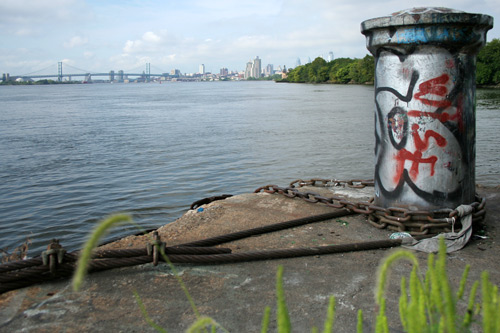
Consider this: the Park West development at 52nd & Jefferson is comprised of a 22 acre section of dormant rail yard and 8 acres where rowhomes had been. That's 31 acres.
The Logan Triangle, fronting Roosevelt Boulevard just east of Broad Street, makes up 33 acres of empty parcels on the city's grid (empty because the homes were condemned
and the city shipped their residents elsewhere). If you add in the physical space the streets occupy, the acreage ups to 40.
Park West is under construction as we speak, and two developers have applied for the Logan Triangle site. (More on this next week.) Thirty-three and forty acres
are pretty big development opportunities, no? If so, then what does that make the 200 acres of Conrail land that sits unused along the Delaware River in Port Richmond?
It's 225 if you include next door's Anderson Yards. (Ha ha, Anderson Yards. Sounds like something you'd see on Friendster.)
The Conrail-Anderson yards (henceforth "Conrail yards") are an integral part of the riverfront planning study. Everyone involved in the planning and everyone paying
attention to that planning is well aware of the otherwise best kept secret in Philadelphia.
I'd go so far as saying that one of the best parks in the city is not a park at all, but a rogue gathering ground, a post-apocalyptic paradise whose very existence I'm
torn even talking about. But there's a whole photo essay waiting.
Twenty different photographers would see the Conrail yards in Port Richmond twenty different ways. One might see it as old man Cramp's shipyard, building wooden
ships for the Civil War and ironclads for both World Wars. Another might see it as the birthplace of the Slinky, before the Slinky moved its operations (down stairs alone
or in pairs) out to Hollidaysburg. Chris Dougherty might see it for the McMyler coal dumpers on Pier 18, one of a dozen piers in the old Port Richmond Wharves. (See the
post directly beneath this one for more on Pier 18 by Chris.)
Or, maybe you'd see the Conrail yards for, well, Conrail. The Consolidated Rail Company has owned the land since the company was formed in 1976 by the consolidation of six
bankrupt railroad companies, both freight and passenger. After two decades of success, Conrail broke up its operations in 1997, with Norfolk Southern and CSX acquiring
most of the network and rolling stock, but with Conrail retaining assets in three areas including Philadelphia and South Jersey.
Conrail still operates the Port Richmond facility, but only along the northern end. The viaduct that parallels Lehigh Avenue was once ten tracks wide -- stand under the
Frankford Ave underpass, look up and count 'em. Nowadays, only one track runs the length of the viaduct; two tracks from directly under 95 to the river. Compare these
three maps:
1927, pre-I-95:
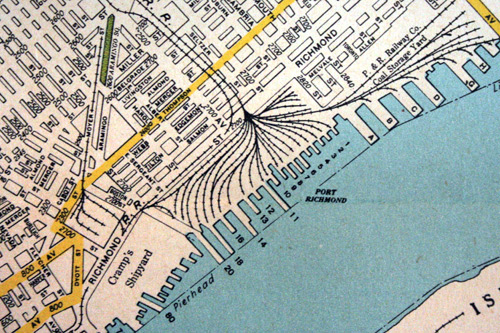 (map by Hagstrom's)
1983, WTF is/was Quay Pier???
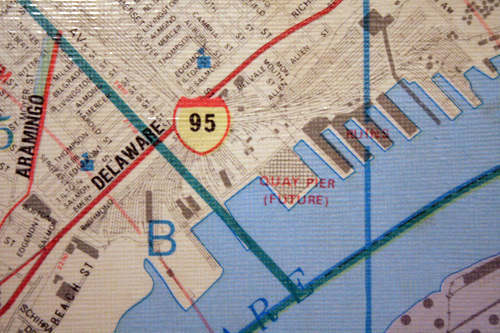 (map by Champion National Map Corporation)
Google maps, 2007:
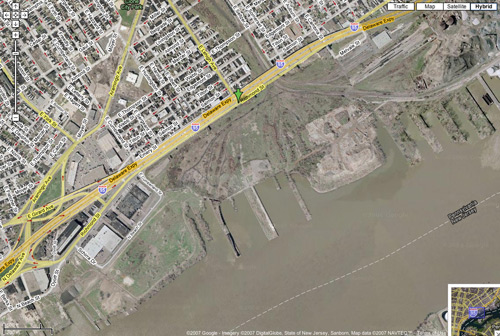
Two hundred twenty-five acres of unused land, from the PECO substation at Penn Treaty Park to the port next to Pulaski Park. Scratch that -- that's 225 acres of
officially (or to sound a bit more draconian, legally) unused land. It's used all right. To four wheelers and dirt bikes and paintballers, it's heaven.
Mounds of dirt and puddles of mud and gravely trails form a steeplechase that answers the questions of many a Kenzo: "exactly where in the hell are those kids on their
dirt bikes riding to?" Chances are, they're riding to the Conrail yards.
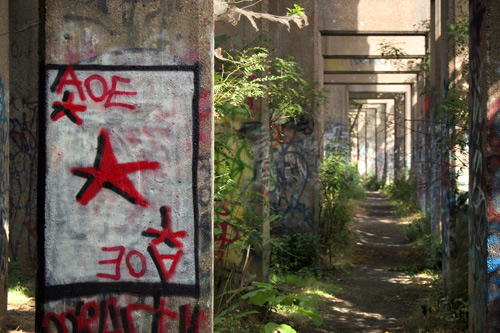
It could be redeveloped, sure. The southern half of it was the site of the proposed Pinnacle casino. You know, the one of the five that made the most sense. It probably
would have been met with the least resistance, too. But, as South Philadelphians and Fishtowners well know, Pinnacle didn't win a license. Besides, Pinnacle has a billion
dollars invested in Atlantic City; their hearts weren't broken.
So here sits 225 acres of land. What's next? For starters, a reconfiguration of the Girard Avenue exit of 95 and reconstruction of a portion of 95. Structurally
deficient and all that, y'see. The last standing Cramp's building will stand no more. Delaware Avenue is supposed to be reconfigured as well, taken a little closer to
the river. With any luck, the grand boulevard of Penn Praxis' riverfront study will take shape, with passenger rail in its own right.
The land itself? I don't know. What do you think? Do you want to see the grid extended all the way to the river, with an all-new neighborhood of rowhomes? That's boring.
An amusement park? OH MY GOD THINK OF THE TRAFFIC. A casino? Ha ha. A giant park? Fairmount Park Commission is strapped enough as it is. A living museum?
Who has the answer? Do you have the answer? If so, let's hear it. Put on yr thinking cap, visualize 225 acres of riverfront land, and send your ideas to blove AT
phillyskyline DOT com. I'll follow this post up next week with the best ones.
For now, have a look at these photos, taken with CDoc two Sundays ago.
–B Love
|
   
19 September 07: Port Richmond: Loadin' Coal
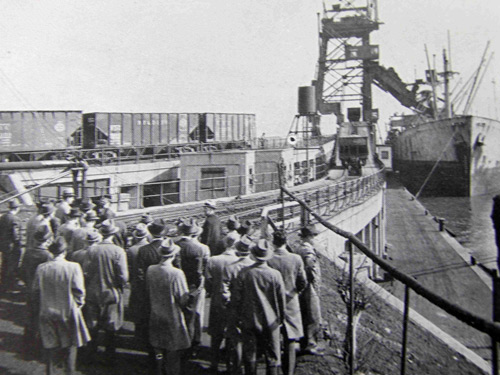
by Christopher R Dougherty
When New York Army Corps engineers demolished an unsightly lattice of steel and concrete that marred the view at a park near the Statue of Liberty, the artist John A.
Noble -- always attentive to the transient quality of port life -- felt the passing of some great ersatz sculpture. "What outdoor sculpture by Picasso or Moore or anyone
else," he wrote of the McMyler coal dumper, "would have so overwhelmed the onlookers from all over the world half as much as a coal car upside down in the sky, held aloft
by this splendid mechanical creation, which was, in its turn, decorated by the long, gracefully undulating hills of trestles?" New York once boasted ten McMyler coal
dumpers and the remnants of Philadelphia's best preserved McMyler sit in a kind of urban rain forest at Pier 18 at the coal wharfs at Port Richmond.
The brainchild of Cleveland engineers John McMyler and George Hulette, the sidecar dumper represented an attempt to whittle away time and labor from the process of moving
coal from rail to ships. In the early days of Port Richmond, men bore wheelbarrows of coal to waiting schooners. As both coal cars and the need for more coal increased,
inventors like the partners George Hulette and John McMyler saw an opportunity to completely mechanize the handling of coal. Instead of developing systems to extract coal,
or systems to better unload coal, these Great Lakes inventors thought to build around the coal car. The McMyler system involved two tracks on a pier. A coal train
approached the track opposite the coal dumper. Upon releasing the car, a gentle decline allowed the coal car to descend down to the end of track where an incline
resembling a ski jump slowed and pushed the car down a lower track. At the end of the lower track the coal car was stopped. Pulleys then elevated the arrested car, dumping
it and its contents down a chute to waiting steamers.
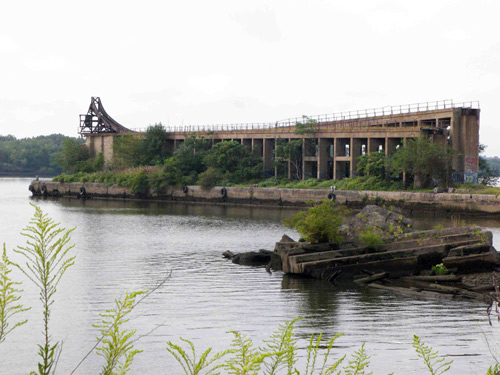
At Port Richmond, only the tracks remain. Port Richmond's McMyler dumper was first constructed in the early part of the century and served the company during its halcyon
period of coal until the 1970s. In Reading Company annual reports, the coal dumper looms large. In 1969, the McMyler was converted from dumping coal to dumping iron ore.
The Reading Company folded in 1976 and it unclear when the steel of Philadelphia's McMyler came down. On top of the McMyler: wire pulley rope and Link Belt winches:
remnants of the former mechanisms that made Port Richmond a masterpiece of moving coal.
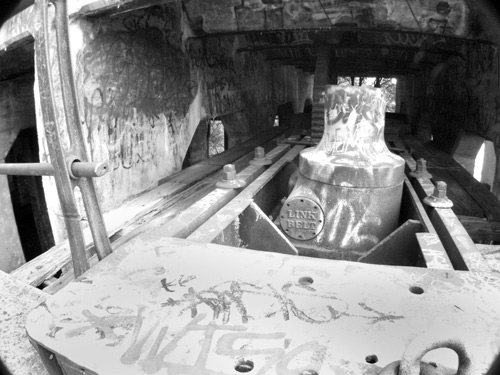
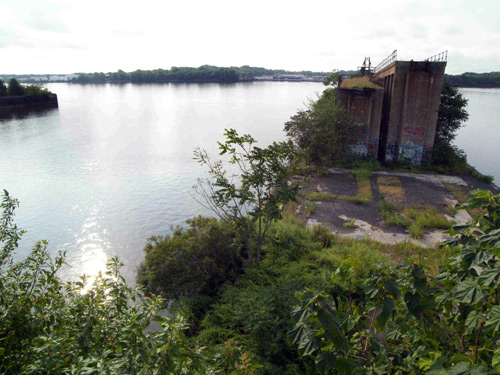
Christopher R Dougherty -- CDoc -- is the author of The Necessity for Ruins and comes from anthracite country,
so he knows a thing or two about coal. He's also been contributing to the Philly History Blog,
whose most recent post is, appropriately enough, The Department of Docks, Wharfs and Ferries: Making Philadelphia's Modern Waterfront.
|
19 September 07: Dark days ahead
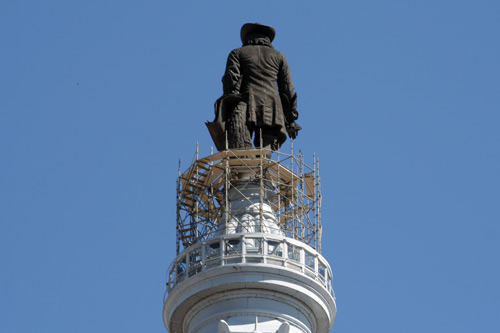
Get a good look at your boy Billy Penn now, because in the next few days, he'll be enshrouded in scaffolding. That scaffolding will last as long as it takes to steam,
clean and wax him. For a 37' statue 110 years old of a guy who lived over three hundred years ago, that's gonna be a lot of wax. But he needs it. We need it. That's
right, we all need a good cleansing. A good wax job. Wax on, wax off. Do it. Wax.
–B Love
|
19 September 07: Coming Attractions
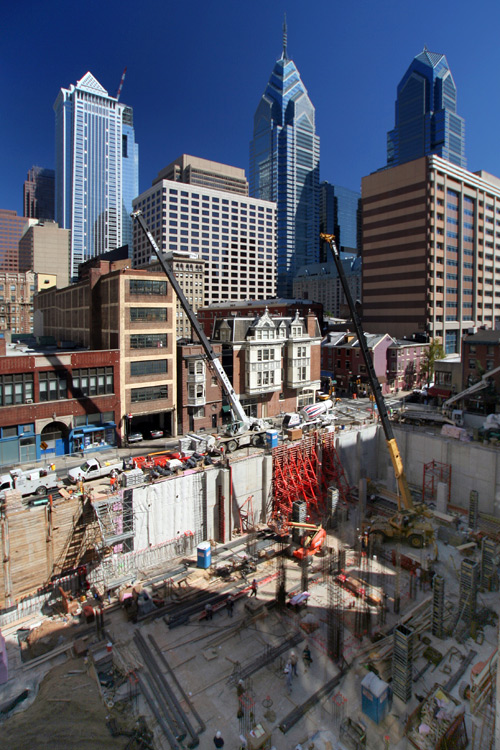
10 Rittenhouse Square under construction - in person at 18th & Sansom and online at Philly Skyline. Stay tooned.
(Photo from 11 o'clock this morning.)
–B Love
|
 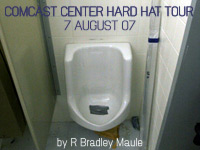
 
19 September 07: I'm walking a line.
I hate to be dreaming in motion
|
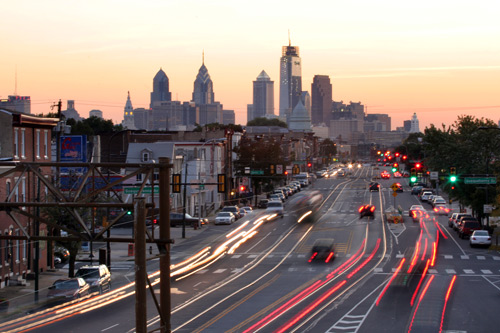
How y'all feelin' out there?
–B Love
|
18 September 07: A painful night of Philadelphia sports,
via transcribed text messages
|
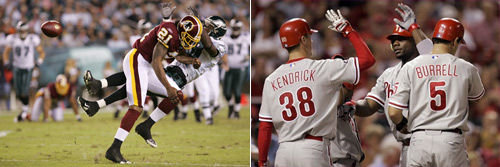 8:12 from B Love: leaving now, see you shortly
8:12 from B Love: leaving now, see you shortly
8:24 from Scott: whats phils score im at eagles game its out of control
8:29 from B Love: dunno, still waiting on septa
9:18 from B Love: 6-0 phils in 5th
9:52 from Pete: howard
9:53 from B Love: hell yeah
9:53 from B Love: howard grand slam, 11-0 phils. hey nice timeout there andy
9:55 from Scott: eagles suck go phillies
10:44 from Scott: eagles suck go phillies [DUPLICATE]
11:30 from B Love: phils win 13-11
12:38 from Steve: Why, after nine seasons, does he still lack the mental toughness? Why do we still have to worry which McNabb will show up? We
live and die with this team every year and get our asses beaten every year for doing so. These losses are the hardest to take.
* * *
They are tough to take, Steve. But for me, at least last night, I don't think it's knowing what the Eagles go through every year, but that Donovan McNabb was
outshone by Jason Campbell on national tv, in a game that the Eagles pretty much had to win. There's a long season ahead to be sure, but after they laid an egg in
Green Bay, it pretty much made the home opener against a division foe a statement game. The Redskins made the statement.
Meanwhile, the Phillies are that much closer to the playoffs, in spite of their pitching. Everyone and their mother knows how bad the Phillies pitching staff is, and how
hard the offense has to compete every single game if it wants to even smell victory. Well, even with a bullpen as bad as the Phillies' is -- that much more when you know
for certain that JC Romero, Brett Myers and Tom Gordon have the night off -- an 11-0 spot is not enough for comfort. Kyle Kendrick has been a pleasant surprise, but he's
good for at least three runs a game, exactly what he gave up after six innings. Enter the bullpen bozos -- Clay Condrey (hit or miss), Jose Mesa (unbelievable that he's
STILL on this team), Antonio Alfonseca (clearly lost the mojo he had earlier in the season) -- and you need Aaron Rowand to go deep off of one of the best closers in
baseball just to salvage a 13-11 win.
I just can't imagine the rift that must exist in the Phillies' dugout and clubhouse between its pitchers and non-pitchers. At least JD Durbin has apologized in the press
for his poor performance. Adam Eaton? Geoff Geary? Mesa? Team spirit can only carry you so far when there appears to be two teams in the clubhouse. I hope I'm wrong. I
probably am. But can't you just see the fire in Chase Utley's eyes going to his hands which are wrapped around Adam Eaton's throat???
Welcome back, Cole Hamels. Take us away, away to the playoffs. Give us something to cheer for before all we're left with is another Eagles disappointment.
–B Love
(NFL photo by John McDonnell, Washington Post; MLB photo by Jeff Roberson, AP via ESPN)
|
 
 
17 September 07: I'd like to use a lifeline
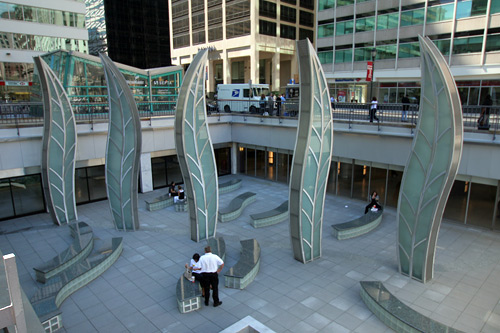
And now, thanks to Septa, you can! In an uncharacteristically sensible move, Septa has finally made the courtyard it worked so hard to restore open again to the public,
despite the retail space next to it not yet being open. Lifelines, Barbara Grygutis' sculptures of aluminum, glass block and lights, are the centerpiece of the
courtyard, and are the showpiece to the renovation of Suburban Station's concourse. Go see the Falafel King right upstairs (falafel & hummus with feta cheese and extra hot
sauce, please) and enjoy your lunch in the finally-open courtyard, huh?
The western end of that concourse will in the next six months lead commuters, couriers and curious pedestrians to the grand staircase inside Comcast Center's atrium. The
eastern and southern ends of Suburban Station lead to Market East and to Patco and Spruce Street, respectively. A photo essay of all of the above -- Philly's underground
city -- is in the works with a target date of next week.
* * *
Lookin' around and lookin' up on Monday Morning, let's see let's see . . .
REVELING RIVAGE, PT 2: The former Rivage site across Kelly Drive from the Falls Bridge in East Falls has itself a new suitor. The RDA
didn't grant an extension to
the previous incarnation of Global City's plans for the site, designed by Old City's MGA Partners and approved by East Falls Development Corp (the EF neighborhood
association). This time around, three proposals were offered -- an expansion of Westrum's enormous neighborhood presence, a Marriott hotel, and a mixed-use development
similar in nature to the previous winner -- and they're archived HERE.
Unsurprisingly, the neighborhood went with the latter, called East Village. Designed by Torti Gallas and Partners (who also designed the MLK homes in Hawthorne, as well as
a number of Washington DC's recent mid-rise developments), East Village presents an honest extension of Ridge Avenue's existing retail corridor. While the design is
relatively conservative, it's perfectly suitable to its location, and the six story apartment/condo building that's the centerpiece of the project features balconies that
mimic (and look out toward) Falls Bridge. A PDF of the project is on the East Falls web site HERE.
BUMMERUMOR: Hearsay/conjecture/unconfirmed: Ludwig's, the only biergarten in Philadelphia, is soon to close its doors at 13th &
Sansom in favor of a new
condo development. And so close to Oktoberfest, too. EH? Say it ain't so, Ludwig. More on this as it develops, but until you hear otherwise, stay thirsty because
Oktoberfest is next weekend (9/29).
THE PHILLIES WILL RIP YOUR HEART OUT: Another weekend, another sweep of the Mets. That makes three this year. If only they could have
played the Marlins and Braves with the same intensity.
Seriously: after the incredible four game sweep at home a few weeks ago, they followed it by losing four of their next six, stamped by the meltdown in Atlanta . . .
without those two series, everyone would be high on Phillies fever coming down the stretch.
As it stands, they're still only three and a half back of the Mets for the division, and a game and a half back of the Padres for the wild card. Has there ever been
such apathy for a team so close to the playoffs? Is it me? Am I just not worn enough on the Phillies experience? (This is my seventh summer here.)
Whatever the case, the Phillies have the Cardinals and Nationals on the road, and the Braves and Nationals at home to close out the season. (I'll report on my DC
experience after the weekend, as I'm heading there for some culture and the Phillies' last series ever at RFK; the Nats' new ballpark opens in April.) The Mets are at
Washington and Florida and then at home against the same two teams with an added makeup game against the Cardinals. They have an easier route to the division than the
Phils do, but anything's possible. The Padres continue their ridiculously scheduled 10 game homestand tonight with four against the Pirates followed by three against the
Rockies, then they hit the road to end the season in San Francisco and Milwaukee.
It ain't gonna be easy, and it's hard to expect the bullpen to keep its momentum, but having Cole Hamels back tomorrow is a step in the right direction. Go Phils.
Monday Monday. It's beautiful out there, baby, and it looks like it's gonna stay that way this week. Get out and enjoy it. If you can't, pretend you can by clicking this
Philly Skyline Philly Skyline, a variation on yesterday's BFB theme.
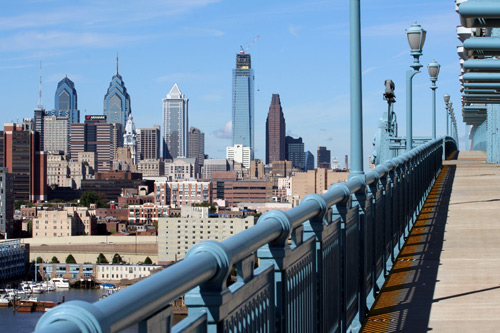
–B Love
|
16 September 07: The life aquatic
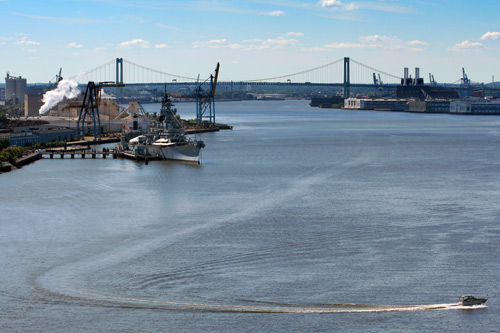
And just like that, summer is out the door. This snappy sunny September weekend made for the perfect opportunity to just get out, so here's hoping you were able to
get a lung full of fresh air. I got mine on the Delaware River just before settling in to watch the Phillies sweep their third series of the year against the Mets.
This mini-essay of Philly Skyline Philly Skylines is from today on the Ben Franklin Bridge's walkway, where it was unusually calm: no harassment from DRPA cops, no shady
characters, no wind at all. Just joggers, lovers and sailors below. Great stuff.
Consider it a preface if you like, as an in-depth look at the Delaware River -- a certain section of it anyway, especially dedicated to you kind and patient folks from
Port Richmond who've asked what's up with the lack of representation on da Skyline -- is coming this week.
Here are a few more photos -- click em all, enlarge em all -- to take it on home.
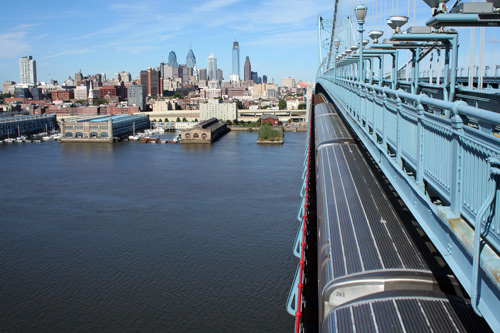


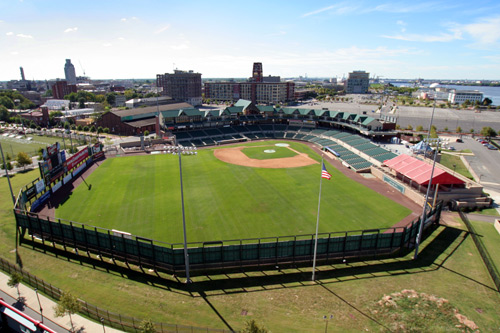
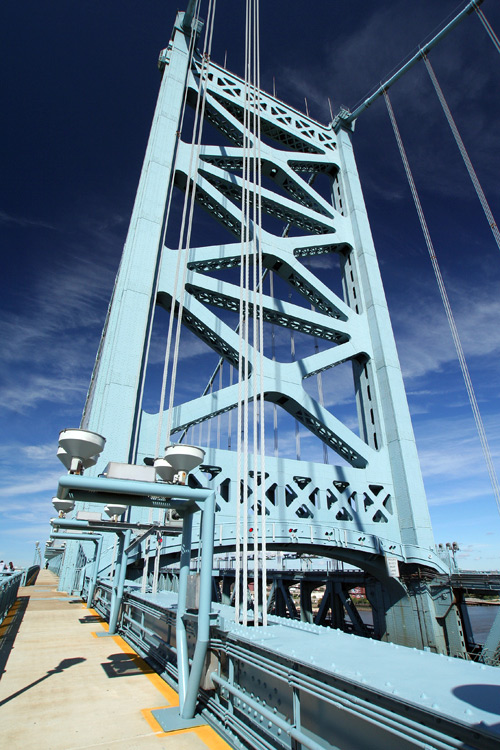
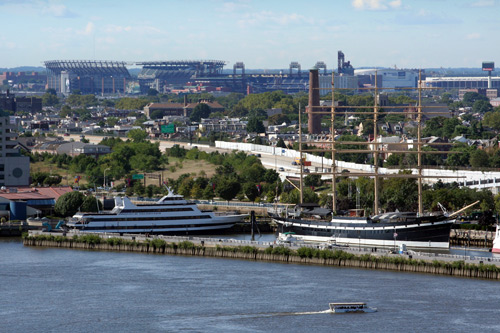
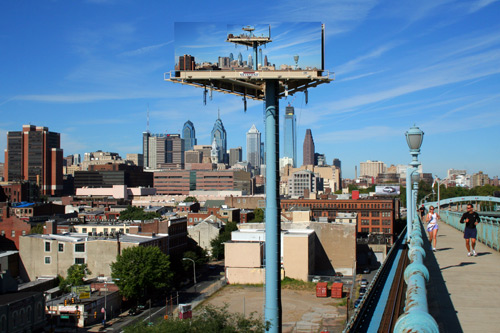
–B Love
|
|





























